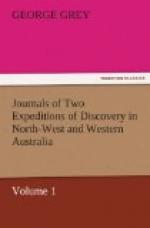Sunday October 22. Latitude 37 degrees 44 minutes south; longitude 38 degrees 00 east.
Caught two small animals, one closely resembling a small shrimp (Penaeus) but having the head covered with a most beautiful purple shield. I kept this alive in a jug. The other in size and appearance exactly like a purple grape (Hyalea) with a greenish tinge at one extremity surrounding an aperture, and a distinct aperture at the other extremity. It was 0.4 inches in diameter, and had the power of emitting a phosphorescent light. I have since this period found several varieties of this animal; which, when it expands itself, closely resembles an insect, and has little wings. Further on will be found a sketch of these animals in their expanded state. (See illustration Hyalea figure 1.)
The Albatross (Diomedea exulans).
We caught four of these birds yesterday, from which I made the following measurements:
First specimen. Weight, 19 1/2 pounds.
Length from tip of wing to tip of wing, 10 feet 2
inches.
Length from tip of beak to tip of tail, 4 feet 0.5
inches.
Length of beak, 6.8 inches.
Length from root to tip of tail, 10.0 inches.
Length of foot, 7.6 inches.
Length of wing, 4 feet 8 inches.
Height from ground, 2 feet 10 inches.
Temperature 98 degrees, the thermometer placed under
the tongue during
life. These measurements were all made during
the lifetime of the bird.
Second specimen. Weight, 15 1/2 pounds.
Length from tip of wing to tip of wing, 10 feet.
Length from tip of beak to tip of tail, 3 feet 11
inches.
Length of beak, 6.6 inches.
Height from ground to top of head, 2 feet 4 inches.
Temperature 98 degrees.
Third specimen. The largest bird of the kind I have hitherto seen.
Length from tip of wing to tip of wing, 10 feet 8
inches.
Length from tip of beak to tip of tail, 4 feet 6 inches.
Breadth across the body, 8 inches.
Length of bill, 6.7 inches.
Length of foot, 7.5 inches.
Fourth specimen. The same size as the second.
Length of beak, 6.3 inches.
Length of foot, 6.9 inches.
The beak of each of these birds during lifetime was of a beautiful light rose colour; their voice was something like that of a goose, but rather louder, deeper, and hoarser. If during life the beak was pressed with the finger it became quite white, and it was not until the pressure had for some time been removed that the colour returned. The specimens I have described above (all males) were quite white underneath; the white above being speckled with black spots and streaks, sometimes changing to a brownish hue; the wings were black. We obtained also a female bird with the following measurements, which has been described as a distinct species:
Length from tip to tip of wing, 7 feet 2 inches.
Length from tip of tail to tip of beak, 3 feet 5.5
inches.
Length from root to tip of tail, 9 inches.
Length of beak, 4.5 inches.
Length of foot, 5 inches.




